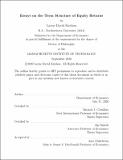Essays on the term structure of equity returns
Author(s)
Kirshon, Layne David.
Download1227094416-MIT.pdf (4.729Mb)
Other Contributors
Massachusetts Institute of Technology. Department of Economics.
Advisor
Ricardo J. Caballero and Alp Simsek.
Terms of use
Metadata
Show full item recordAbstract
This dissertation contains three essays on the term structure of equity returns. In the first chapter I document substantial variation in the cross-section of the term premium of US stocks between 1996 and 2019. I introduce a model with multiple stocks and an SDF with two priced sources of risk - dividend volatility risk and discount rate risk - which generates an economy with both upward and downward sloping equity term structures. The model creates two hypotheses: (1) dividend strips of stocks with more volatile dividends should earn higher returns, and (2) controlling for dividend volatility, cash flow duration should increase a stock's term premium. I use the Fama-French factors to empirically validate the model, with factor regressions explaining the majority of variation in term premia. The second chapter studies the relationship between the low volatility anomaly and the equity term structure. I show that dividend strip returns are positively related to measures of risk and volatility, while term premium returns are negatively related to risk and volatility. This generates a puzzle for explanations of the low volatility anomaly based on general preference for volatility, such as leverage constraints, that cannot distinguish across the term structure. The results support market specific explanations such as behavioral models of utility over realized gains (as opposed to unrealized paper gains) from investments. The third chapter studies the effect of buybacks on the equity term premium. First, I show that firms that conduct a buyback for the first time see an immediate drop in the returns to their dividend strips (due to unfulfilled dividend expectations), and a concurrent increase in their term premia. This confirms that buybacks do indeed substitute for dividends. Second, I show that firms that have repurchased shares earn a "buyback premium" due to the fact that cash flows may be returned as repurchases instead of dividends.
Description
Thesis: Ph. D., Massachusetts Institute of Technology, Department of Economics, September, 2020 Cataloged from student-submitted PDF of thesis. Includes bibliographical references.
Date issued
2020Department
Massachusetts Institute of Technology. Department of EconomicsPublisher
Massachusetts Institute of Technology
Keywords
Economics.